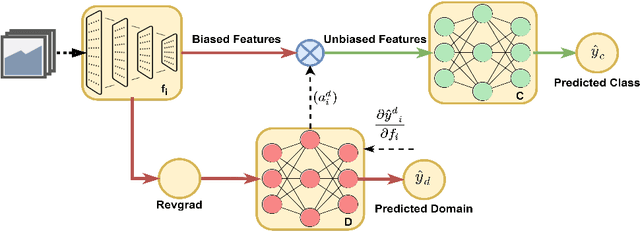Yash Vardhan Sharma
Gradient Based Activations for Accurate Bias-Free Learning
Feb 17, 2022



Abstract:Bias mitigation in machine learning models is imperative, yet challenging. While several approaches have been proposed, one view towards mitigating bias is through adversarial learning. A discriminator is used to identify the bias attributes such as gender, age or race in question. This discriminator is used adversarially to ensure that it cannot distinguish the bias attributes. The main drawback in such a model is that it directly introduces a trade-off with accuracy as the features that the discriminator deems to be sensitive for discrimination of bias could be correlated with classification. In this work we solve the problem. We show that a biased discriminator can actually be used to improve this bias-accuracy tradeoff. Specifically, this is achieved by using a feature masking approach using the discriminator's gradients. We ensure that the features favoured for the bias discrimination are de-emphasized and the unbiased features are enhanced during classification. We show that this simple approach works well to reduce bias as well as improve accuracy significantly. We evaluate the proposed model on standard benchmarks. We improve the accuracy of the adversarial methods while maintaining or even improving the unbiasness and also outperform several other recent methods.
Surrogate-assisted distributed swarm optimisation for computationally expensive models
Jan 18, 2022Abstract:Advances in parallel and distributed computing have enabled efficient implementation of the distributed swarm and evolutionary algorithms for complex and computationally expensive models. Evolutionary algorithms provide gradient-free optimisation which is beneficial for models that do not have such information available, for instance, geoscientific landscape evolution models. However, such models are so computationally expensive that even distributed swarm and evolutionary algorithms with the power of parallel computing struggle. We need to incorporate efficient strategies such as surrogate assisted optimisation that further improves their performance; however, this becomes a challenge given parallel processing and inter-process communication for implementing surrogate training and prediction. In this paper, we implement surrogate-based estimation of fitness evaluation in distributed swarm optimisation over a parallel computing architecture. Our results demonstrate very promising results for benchmark functions and geoscientific landscape evolution models. We obtain a reduction in computationally time while retaining optimisation solution accuracy through the use of surrogates in a parallel computing environment.
 Add to Chrome
Add to Chrome Add to Firefox
Add to Firefox Add to Edge
Add to Edge